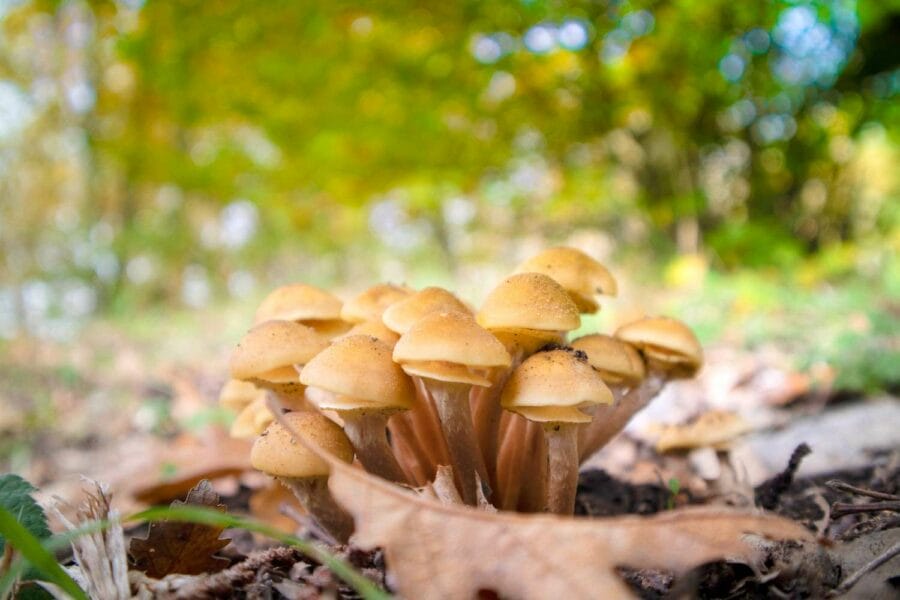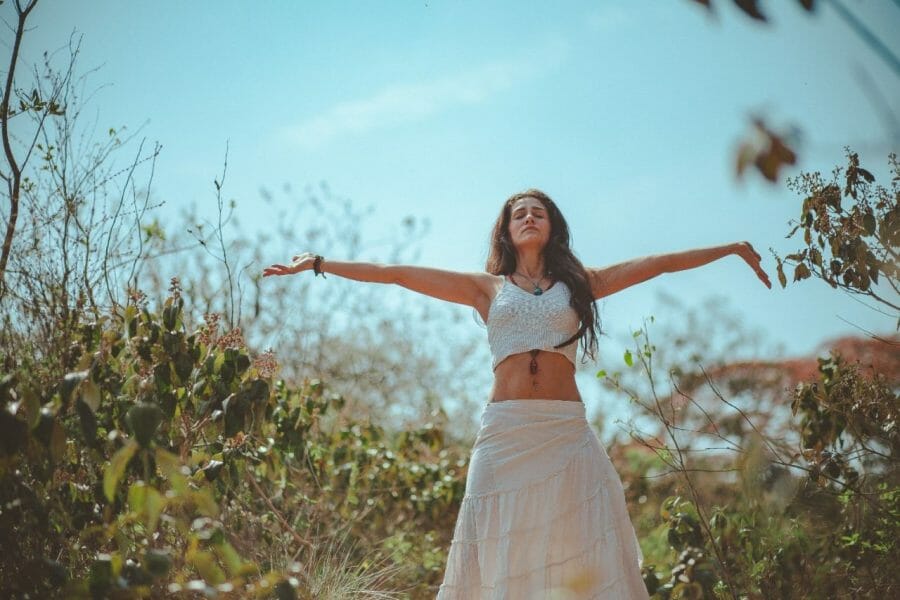Psilocybin, the psychoactive compound found in magic mushrooms that’s renowned for its ability to induce euphoria and hallucinations, is often used for recreational purposes.
Beyond its mind-altering effects, research has delved into the compound’s potential to provide relief from chronic pain.
This article offers a case study on how microdosing mushrooms could assist in alleviating chronic pain.
Key Takeaways:
- Microdosing mushrooms may provide both immediate and sustained pain relief.
- In comparison to standard pain medications, psilocybin microdosing usually yields fewer side effects when given in small doses.
- Psilocybin engages with the serotonin 2A (5-HT2A) receptors, helping to alleviate pain among other conditions.

The Study
Dr. Matthew Lyes and his team from the Division of Pain Medicine in the Department of Anesthesiology at the University of California, San Diego, conducted a study titled “Microdosing Psilocybin for Chronic Pain: A Case Series“. The study focused on three patients who self-administered small quantities of psilocybin to control their chronic pain symptoms.
Three Patients, One Result – Chronic Pain Relief
Patient # 1
| AGE/ GENDER: | 37 Male |
| PAIN TYPE: | Neuropathic pain occurring below the site of a spinal cord injury. |
| PAIN INTENSITY: | Starts at 4 to 5/ 10, increasing to 8/ 10 later in the day |
| PSILOCYBIN DOSE: | 250 mg of ground mushroom for less than 6 months |
| OUTCOME: | Discontinuation of prescribed pain medication, decreased muscle spasms, and improved bowel movement efficiency. No signs of rebound pain or withdrawal symptoms. |
| The patient reported that psilocybin did more than just dull the pain like his regular medications did — it effectively silenced it, reducing his average pain level from 5 to 0. | |
Case Study: Second Patient
| AGE & GENDER: | 69, Female |
| PAIN TYPE: | Complex Regional Pain Syndrome (CRPS) |
| PAIN INTENSITY: | Typically between 5 and 7 on a scale of 10, but can increase with physical activity or during pain flare-ups |
| PSILOCYBIN DOSAGE: | Daily dose of 500 mg for 7 to 10 days with rest periods (2 to 3 days) over a year. Dosage increases to 750 mg to 1 gram during pain flare-ups |
| EFFECT: | Reduces pain by 80% for 3-4 hours, with pain levels gradually returning to initial levels after 12 hours. Complete pain relief (90%-100%) lasts 6-8 hours, returning to initial levels after 18 hours. |
| The patient exhibits a decreased appetite without nausea. Upon increasing the dosage (750 to 1000mg), disorientation or instability in walking is observed. | |
Case Study: Third Patient
| AGE & GENDER: | 40, Female |
| PAIN TYPE: | Lumbar radiculopathy and neuropathic pain |
| PAIN INTENSITY: | 8 on a scale of 10, but can rise to 10 during physical activities |
| PSILOCYBIN DOSAGE: | 1000 mg from a mushroom chocolate bar every two months |
| EFFECT: | Significant pain relief without any psychoactive effects. Improved flexibility and functionality noted. Pain gradually returns to initial levels over a period of 2-4 weeks. Repeated dosing enhances pain control. |
| The patient does not experience any significant physical, cognitive, or behavioural side effects. Her mood remains largely stable. She maintains her regular dosage of her SSRI for depression management throughout the psilocybin treatment period. | |
Deciphering Pain Management with Psilocybin
Constant somatic and visceral pain signals fortify specific neural pathways due to peripheral and central sensitization, resulting in the enduring experience of pain, both physically and emotionally. Psychedelics like psilocybin trigger 5-HT2A receptors, potentially resetting the brain areas linked with neuropathic conditions.
One patient reported durable pain relief lasting for weeks. This suggests that after directly stimulating the 5-HT2A receptors, there can be a central regulation of pain perception and adaptability.
Potential Side Effects: A Comparison Between Psilocybin and Conventional Pain Relievers
| PSILOCYBIN (Based on Scientific Studies) | TRADITIONAL PAIN RELIEVERS |
| Muscle spasms | Nausea |
| Decreased appetite | Stomach discomfort |
| Confusion | Migraines |
| Impaired balance | Dependency |
| Absence of mood changes | Drowsiness |
Prospective Psilocybin Research Areas
Based on the experiences of three participants, the research team identified potential areas for further investigation due to their potential benefits.
- Small doses of psilocybin could provide immediate and possibly sustained relief from neuropathic pain, without the risk of physical tolerance or addiction.
- Explore the impact of different treatment approaches in conjunction with psilocybin. For instance, patient #3 reported an increased pain-relieving effect when psilocybin was used in tandem with physical therapy.
- Even without psychotherapy, minor doses of psilocybin might alleviate pain, as demonstrated in this case study. The researchers propose that incorporating therapeutic guidance could potentially enhance or prolong the therapeutic outcomes.
Study Limitations
Despite encouraging observations in the patients, it’s important to acknowledge the limitations identified in the study.
- The limited sample size might not fully represent the entire population of individuals dealing with neuropathic pain.
- The study didn’t include any participants who were resistant to psilocybin.
- There were no assessments conducted before and after the treatment to measure the impact of psilocybin on psychiatric disorders like depression and anxiety.
- Most of the data was based on self-reporting by the subjects.
- The interviewer’s presence and potential biases associated with psilocybin could have influenced the participants’ responses.
- The study didn’t investigate the potential influence of the placebo effect.
- The study did not ascertain the psilocybin content in each mushroom.
Microdosing Psilocybin Mushrooms
In the current research, both patients #1 and #2 consumed a small dosage of psilocybin, which was sourced from dried mushrooms and powdered, whereas patient #3 combined it with chocolate. There is a wide variety of products tailored for psilocybin microdosing, and we have curated a selection of them below.
Dried Psilocybin Mushrooms
Although the specific strain utilized in this study wasn’t disclosed, the strain mentioned below serves as an excellent beginner’s choice.
- Golden Teacher: A popular and widely available strain of psychedelic mushrooms.
- Amazonian Cubensis: This strain is user-friendly and known to offer cognitive enhancements.
- Cambodian: Microdosing with Cambodian cubensis mushrooms may boost focus, social awareness, and overall mood.
Psilocybin Microdose Capsules
- Euphoria Psychedelics – Micro Calm Capsules: This formulation includes Ashwagandha, Reishi, CBD, Valerian root, and Psilocybin Mushrooms, all of which have been scientifically demonstrated to alleviate anxiety and stress.
- Ground Sounds – Microdose Capsules – Champion Lover: This intriguing blend provides three dosage options: 50mg, 100mg, or 250mg of pure psilocybin paired with reishi, cacao, cordyceps, and maca.
- Kind Stranger – Brighten Capsules 250mg: These capsules feature the Golden Teacher strain, which is renowned for promoting clear thinking, enhanced creativity, and heightened focus.
Using Psilocybin for Pain Relief
While the study of mushrooms’ analgesic properties is still nascent, promising signs are emerging from anecdotal reports and preliminary case studies.
These instances underscore the necessity for more comprehensive research into the potential advantages of psilocybin, class=”wp-block-list”>
Especially in the field of chronic pain management, psilocybin is gaining increasing recognition.
Before psilocybin was widely accepted as an effective pain relief method, hopeful narratives from case studies provided comfort to those living with chronic pain.
Frequently Asked Questions
What are the effects of microdosing psilocybin?
Psilocybin primarily stimulates a serotonin receptor known as “5-HT2A” in the prefrontal cortex, leading to two key effects:
- Generation of “Brain-Derived Neurotrophic Factor” (BDNF)
- Enhanced “Glutamate” transmission
Moreover, psychedelics promote connections among brain regions that typically communicate less frequently. This distinctive connectivity is a side effect of psychedelics’ ability to suppress the activity of the “Default Mode Network” (DMN), which is linked to numerous cognitive functions, such as daydreaming, introspection, and contemplation about the past and future.
What is the most recognized benefit of microdosing mushrooms?
Microdosing can potentially enhance mood, productivity, creativity, and concentration. The most extensively researched benefit is its influence on mental health.
In November 2022, COMPASS Pathways, a mental health company, disclosed the results of their extensive phase 2b trial, which was randomized and double-blind. Their findings indicated that a single dose of psilocybin significantly reduced depressive symptoms compared to a placebo. Participants who received a larger dose of 25 milligrams showed a lasting antidepressant response at the twelve-week follow-up.
A study published in the Psychiatry Research Journal suggested that psilocybin is more effective than traditional antidepressant treatments.
How can you determine your dosage?
Start with a 0.1-gram dose of psilocybin mushrooms on the first day. If the desired effects are not reached, you can gradually increase your dose by 0.05 grams on subsequent microdosing days until you find your ideal dose.
Those with a history of using psychotropic drugs may need to increase the dose to 0.5 grams to obtain the desired effects.
What should you do before consuming mushrooms?
What is the suggested frequency for microdosing mushrooms?
Various well-established protocols suggest defined microdosing schedules for psychedelics. The primary difference among these protocols is the inclusion of “off” days – days when you abstain from microdosing.
The most common protocols recommend integrating 1-3 rest days between microdoses. This aligns with the body’s innate tolerance mechanisms. The three protocols under consideration here are the Fadiman Protocol, the Stamets Stack, and intuitive microdosing.




